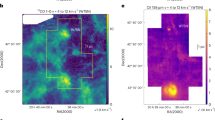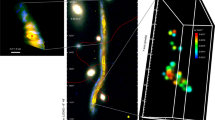Abstract
Stars are known to form in clouds of cold molecular hydrogen, which are relatively poorly understood despite being one of the main components of the interstellar medium. The problem is that H2 is invisible in the cold interstellar medium, so its distribution and motion must be inferred from observations of minor constituents of the clouds, such as carbon monoxide and dust. Most of our present knowledge comes from observations of CO emission, but there is much debate on whether this is an effective tracer of H2: it might miss a large fraction of the molecular gas1. It is difficult to address this question on the basis of observations within the Milky Way alone, whose edge-on orientation makes it hard to discern the distant cloud structures. We have therefore surveyed the CO emission of the molecular clouds of M31 (the Andromeda galaxy), the nearest spiral galaxy to the Milky Way, and investigated the extent to which it follows the extinction of starlight by dust. We find a remarkably tight association between the CO emission and the dust, from which we conclude that CO does indeed trace all of the molecular gas.
This is a preview of subscription content, access via your institution
Access options
Subscribe to this journal
Receive 51 print issues and online access
$199.00 per year
only $3.90 per issue
Buy this article
- Purchase on Springer Link
- Instant access to full article PDF
Prices may be subject to local taxes which are calculated during checkout



Similar content being viewed by others
References
Maloney, P. & Black, J. H. Molecular gas abundances in galaxies. Astrophys. J. 325, 389–401 (1988).
Stanek, K. Z. & Garnavich, P. M. Distance to M31 with the HST and Hipparcos Red Clump Stars. Astrophys. J. Lett. 503, L131–L134 (1998).
Hodge, P. The Andromeda Galaxy Ch. 10–12 (Astrophysics and Space Science Library, Vol. 176, Kluwer, Dordrecht, 1992).
Walterbos, R. A. M. & Kennicutt, R. C. J An optical study of stars and dust in the Andromeda galaxy. Astron. Astrophys. 198, 61–86 (1988).
Brinks, E. & Shane, W. W. Ahigh resolution H Iline survey of M 31. Astron. Astrophys. Suppl. 55, 179–251 (1984).
Dame, T. M. et al. Acomplete CO survey of M 31. Astrophys. J. 418, 730–742 (1993).
Loinard, L. et al. Molecular spiral arms in M 31. Astrophys. J. 469, L101–L104 (1996).
Loinard, L. & Allen, R. J. Cold massive molecular clouds in the inner disk of M 31. Astrophys. J. 499, 227–233 (1998).
Tilanus, R. P. J. & Allen, R. J. Spiral structure of M 83. Astron. Astrophys. 274, 707–729 (1993).
Bohlin, R. C., Savage, B. D. & Drake, J. F. Asurvey of interstellar HI from Lα absorption measurements. Astrophys. J. 224, 132–142 (1978).
Rand, R. J., Kulkarni, S. R. & Rice, W. Star formation and the distribution of HI and infrared emission in M 51. Astrophys. J. 390, 66–78 (1992).
Guélin, M. et al. 1.3 mm emission in the disk of NGC 891: evidence of cold dust. Astron. Astrophys. 279, L37–L40 (1993).
Guélin, M. Cold dust emission from the spiral arms of M 51. Astron. Astrophys. 298, L29–L32 (1995).
Blair, W. P., Kirshner, R. P. & Chevalier, R. A. Abundance gradients in M 31. Astrophys. J. 254, 50–69 (1982).
Walterbos, R. A. M. & Schwering, P. B. W. Infrared emission from interstellar dust in the Andromeda Galaxy. Astron. Astrophys. 180, 27–49 (1987).
Strong, A. W. & Mattox, J. R. Gradient model analysis of EGRET diffuse Galactic γ-ray emission. Astron. Astrophys. 308, L21–L24 (1996).
Braun, R. Distribution and kinematics of neutral gas in M 31. Astrophys. J. 372, 54–66 (1991).
Maddalena, R. J. et al. The large system of molecular clouds in Orion and Monoceros. Astrophys. J. 303, 375–391 (1986).
Heyer, M. et al. the FCRAO CO survey of the Outer Galaxy. Astrophys. J. Suppl. 115, 241–258 (1998).
Garcıa-Burillo, S., Guélin, M. & Cernicharo, J. CO in M 51. I. Molecular spiral structure. Astron. Astrophys. 274, 123–147 (1993).
Emerson, D. T. & Gräve, R. The reduction of scanning noise in raster scanned data. Astron. Astrophys. 190, 353–358 (1988).
Hoernes, P. Thesis, Univ. Bonn (1997).
Acknowledgements
We thank the IRAM Granada staff, particularly A. Sievers and W. Brunswig, and P.Hoenes from MPIfR for their important role in developing the ‘on-the-fly’ observation and data-reduction procedures. We also thank E. Brinks and N. Devereux for making available their H Iand Hα data.
Author information
Authors and Affiliations
Corresponding authors
Rights and permissions
About this article
Cite this article
Neininger, N., Guélin, M., Ungerechts, H. et al. Carbon monoxide emission as a precise tracer of molecular gas in the Andromeda galaxy. Nature 395, 871–873 (1998). https://doi.org/10.1038/27612
Received:
Accepted:
Issue Date:
DOI: https://doi.org/10.1038/27612
Comments
By submitting a comment you agree to abide by our Terms and Community Guidelines. If you find something abusive or that does not comply with our terms or guidelines please flag it as inappropriate.



